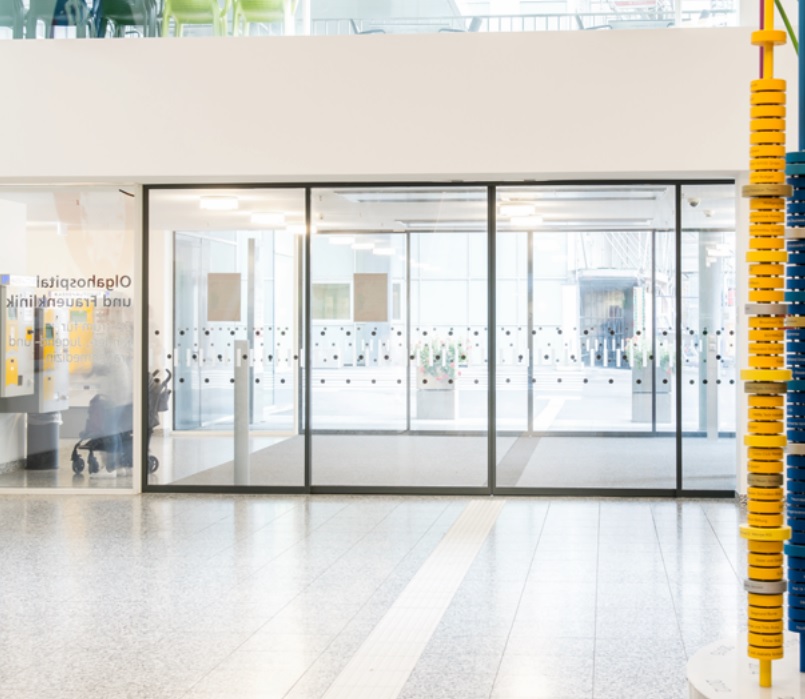The Coronavirus pandemic has highlighted the importance of infection prevention and control, particularly in health and care settings.
Airing rooms regularly, avoiding contact where possible, and frequently washing and disinfecting our hands – we are all aware of the growing importance of hygiene measures.
However, complying with hygiene measures presents new challenges, both in our daily lives and in the workplace.
And there is a pressing need for innovative solutions to improve hygiene while offering added convenience, especially in healthcare buildings.
To address this issue, Geze, a manufacturer of door and
window control systems, has launched Helping Healthcare to Heal, an initiative created to recognise that putting patients at the centre of hospital, clinic, and doctors’ surgery building design can help in the process of healing and recovery.The COVID-19 pandemic has brought an intense focus on all aspects of healthcare in the UK and, as we look ahead, it’s likely that its impact will continue for some sometime with long-lasting changes to the building design of hospital and healthcare facilities
And touchpoints are key, with healthcare operators increasingly specifying more-hygienic, low-contact solutions for common fixtures and fittings.
The document looks at a number of areas, including:
- Preventing environmental stresses such as noise from slamming doors or a lack of privacy without creating barriers
- Enabling patients and residents to be as close to nature as possible through outdoor views, sufficient sunlight, and fresh air
- Giving patients and residents a feeling of control by being offered opportunities to access outside spaces and move around safely and contact free
The brochure looks at providing solutions for the hygiene, safety, and wellbeing of not only patients, but healthcare workers as well.
And it reviews each area of a healthcare building in detail, identifying the key issues, whether it is comfort, safety, hygiene, attractive design, sustainability, accessibility, or fire safety, and providing advice on overcoming them.
For example, in entrance areas it suggests the installation of automatic door systems, which enable people to come and go without physically touching doors.
In turn, these solutions also minimise noise pollution and promote easy access for people with limited mobility.
Similar products can also be used in corridors and other circulation spaces which have a heavy footfall throughout the day.
In patient rooms, the document promotes the use of intelligent room partitions, such as sliding door systems; and noise-reduction solutions such as sound dampening materials and soft-closing doors.
While for public areas, cafes, and waiting rooms, automated window systems controlled by sensors and carefully-co-ordinated building automation can provide fresh air which improves indoor air hygiene and reduces the risk of viruses spreading.
And, in high-risk areas such as dedicated COVID wards, products like automatic doors, sliding doors, and access control systems ensure the highest hygiene standards while maintaining accessibility and safety.
Andy Howland, sales and marketing director at Geze, said “The COVID-19 pandemic has brought an intense focus on all aspects of healthcare in the UK and, as we look ahead, it’s likely that its impact will continue for some sometime with long-lasting changes to the building design of hospital and healthcare facilities.

In public areas and entrances, sliding and automatic doors and windows can help to provide a constant supply of fresh air and aid infection prevention and control by reducing the number of touchpoints
“At GEZE we support clients and architects as they consider these design implications in new construction and refurbishments to existing buildings.”
Automated, hands-free building solutions also help with cleaning.
The report states: “Practical and efficient solutions can facilitate cleaning and work processes and ensure cleaning personnel can do their work properly.
“Door closers with a hold-open function, for instance, make door stoppers mounted on the floor unnecessary. This makes room hygiene easier, because the floor can be cleaned without obstacles.
“Ventilation is another good example of where to save time and costs as opening all doors and windows at once facilitates more-efficient ventilation. ”
To read the report in full, click here.
